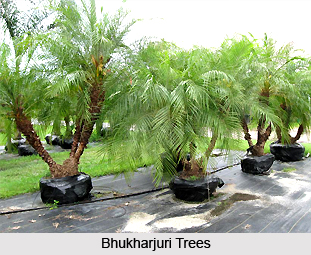Bhukharjuri or Dwarf Date Palm is known as Phoenix acaulis Buch, scientifically. Apart from this in Hindi this Indian medicinal plant is known as Jangli Khajur, Khajur, Pind Khajur, Thakal; in Marathi it is known as Boichind, Shevra, Shilind; Oriya: Kojiri and in Telegu it is called Yita.
 Bhukharjuri is extensively found in the outer Himalayas, the Khasi and Naga hills of Meghalaya and Nagaland and also in Bihar, Orissa, Central India and in peninsular India. Khajur tree is dominant in Satpura hills and in grassy areas of the country; it particularly thrives on clayey soils. The roots and the pith of Bhukharjuri are used as aperients. The pith of the Bhukharjuri stem is edible, and yields a type of fruits that are tender peduncles and the terminal leaf buds of the Bhukharjuri tree are also edible.
Bhukharjuri is extensively found in the outer Himalayas, the Khasi and Naga hills of Meghalaya and Nagaland and also in Bihar, Orissa, Central India and in peninsular India. Khajur tree is dominant in Satpura hills and in grassy areas of the country; it particularly thrives on clayey soils. The roots and the pith of Bhukharjuri are used as aperients. The pith of the Bhukharjuri stem is edible, and yields a type of fruits that are tender peduncles and the terminal leaf buds of the Bhukharjuri tree are also edible.
Bhukharjuri is a short stem-less palm with a thick, ovoid base that is 15-25 cm in diameter and is covered with persistent leaf bases. Bhukharjuri leaves are pinnate in shape and 0.6-1.8 m long. The pinnae of Bhukharjuri tree are linear, stiff and 25-50 cm long, base thickened; and the lowest leaflets are reduced to sharp spines. Bhukharjuri flowers are borne in compressed, branched spadices that are longer than the spathe. The fruit is oblong-ellipsoid in shape and around 1.7 cm long. The bright red fruit turns blue-black when ripe, it is edible and the containing seeds are oblong and grooved. The flowering in Khajur tree occurs mainly in April and May and fruiting occurs in May and June.
This article is a stub. You can enrich by adding more information to it. Send your Write Up to [email protected]



















